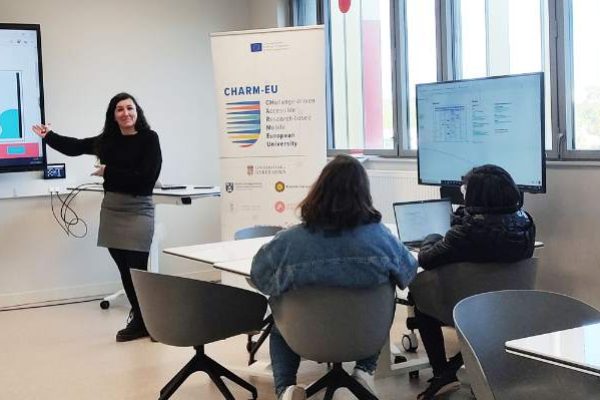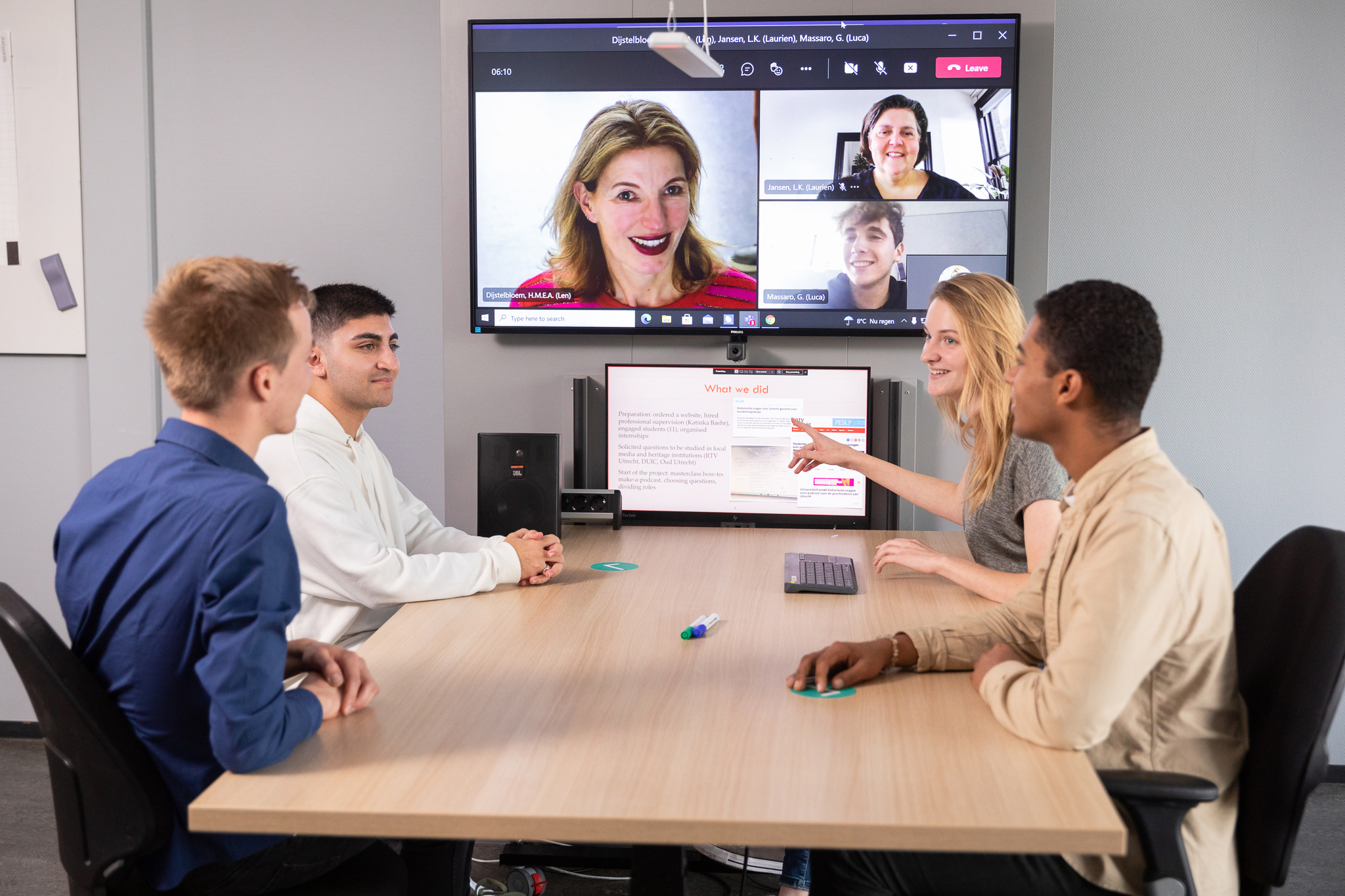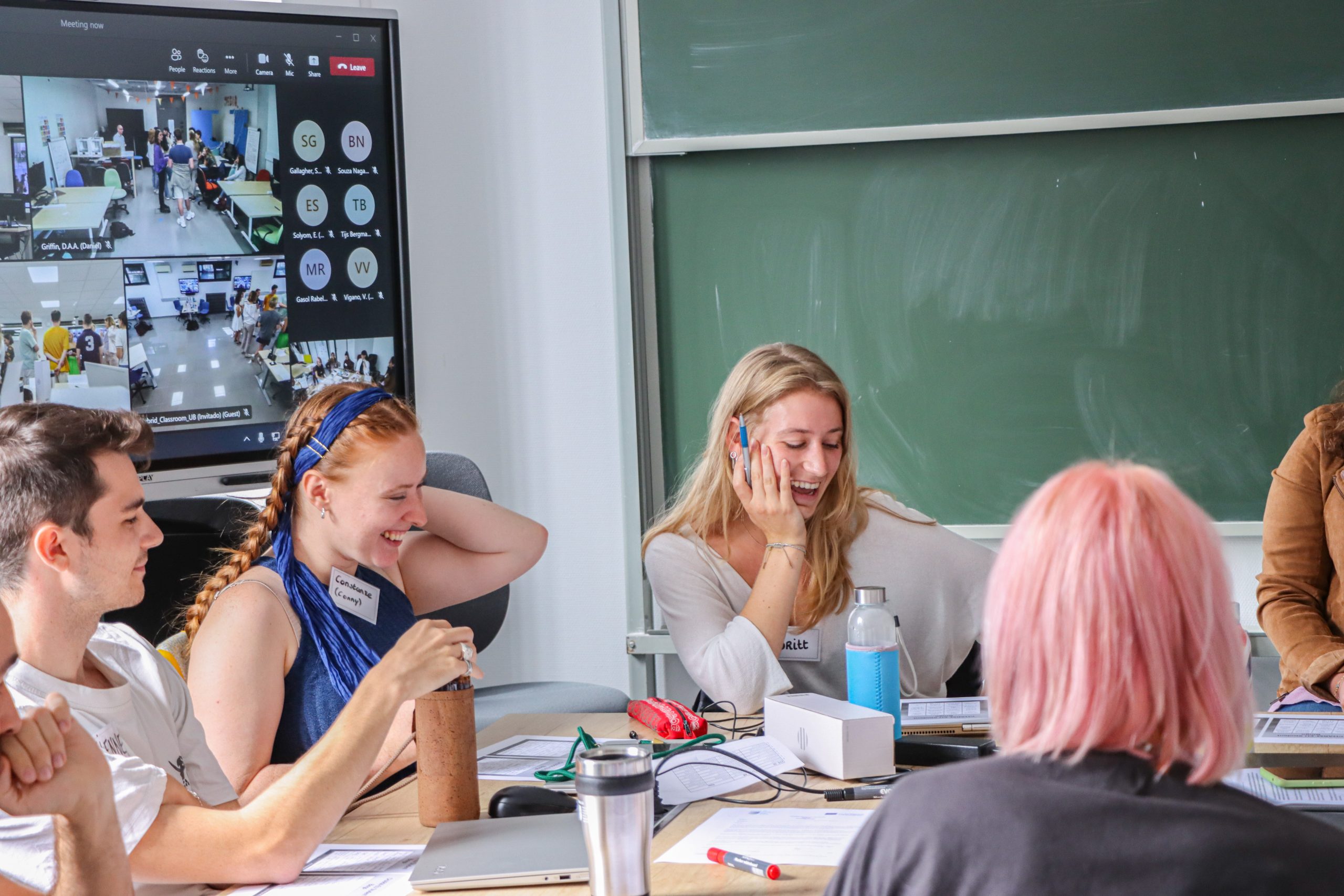The European University Alliance CHARM-EU is experimenting with innovative teaching and learning. In the master’s program ‘Global Challenges for Sustainability’, the alliance is actively testing innovative concepts. The program is attended synchronously by students in five different CHARM-EU universities through hybrid active learning classrooms. These are interconnected high-tech rooms designed for both local and remote education. In this article, we explore CHARM-EU’s experiences and insights gained from the use of those spaces which make European collaboration tangible and visible in everyday practice.

Vanessa Vigano from the IT department of the University of Montpellier has been involved from the start in setting up the hybrid classrooms for CHARM-EU. She shares valuable lessons learned during the initial two years of joint teaching in these hybrid learning spaces.
What are CHARM-EU Hybrid Classrooms?
CHARM-EU’s hybrid classrooms are innovative, high-tech spaces designed for students across the alliance. They are, in a way, the physical component of the Virtual Learning Environment. The classrooms have contain advanced features like pods with separate screens and cameras, plus flexible furniture. This ensures connectivity of student teams who work in different locations. In this way, they align with CHARM-EU’s pedagogical principles, offering modular configurations that allow both collaborative and independent work. Inclusivity is prioritized, with provisions for both in-person and remote learning scenarios. The design is not only functional but also welcoming, cozy, and plans include introducing a mascot in each classroom for an enhanced learning experience.

What are the main features of those classrooms?
Hybrid classrooms were conceptualized and planned during the COVID era. The Hybrid Classroom team comprised a representative from each participating university’s IT or educational department. We started with a research phase, where we gathered the needs and expectations for these spaces by consulting both the teaching staff and prospective students regarding activities and modalities.
Subsequently, we set up the classrooms. The classroom’s modularity and connectivity are paramount, ensuring that students entering their local hybrid classroom in Barcelona, Montpellier, Utrecht, Budapest, or Dublin are essentially entering a unique European course.
To align with the pedagogical principles of Challenge-Based Learning and a student-centered approach, we organized the spaces in a modular way. We wanted students to be able to work collaboratively or independently, as needed. We opted for furniture on wheels and introduced our workstations, also called ‘pods’. Each workstation accommodates two to five students, potentially interconnected throughout the classrooms in the five different countries.
Last but not least: CHARM-EU strives to offer the same quality of education at each partner university location, regardless of varying institutional policies and budgets. We want to ensure uniformity of technology across universities to promote equality and inclusivity.
We have heard about the cozy corner: what is that?
Even though hybrid classrooms are highly modular and high-tech, we planned to support informal interaction and create a welcoming atmosphere in our prototype.
This is an ongoing effort that includes the so-called cozy corner —a section in the classroom with a comfortable sofa, providing a relaxed environment where students can unwind and feel a sense of safety, reminiscent of being closer to home. As students sometimes spend an entire teaching day in these classrooms, we aim to make them more personal. Relaxed moments are essential for the learning process. Emotions are an important aspect of the learning process! The process on implementing cozy corners is ongoing.

What feedback do you get from students and teachers on the hybrid classrooms?
Overall, students and teaching staff are pleased with our classrooms. Still, we have received valuable feedback that will be incorporated in the upcoming cohorts. While some students appreciate the flexibility and interactivity, others feel that the setup does not make optimal use of local groups and the potential for organizing activities locally.
Teaching staff find hybrid classrooms challenging, but they value the opportunity for simultaneous active participation from different student groups located in different countries and gaining a different perspective on their roles.
What are lessons learnt so far?
A task group within CHARM-EU has collected the lessons learnt of the past two years. We do have some technical aspects that we should finetune, for example, the microphone quality is really crucial for long sessions hybrid session. You do need really to have very good audio set-up that picks up the sounds you need. If this is not good, students have a hard time to concentrate.
Another lesson learnt is that the teaching assistants who are present in each classroom, have a very important role. They provide the technical know-how to run the class smoothly in terms of equipment, but they also facilitate the teachers and provide a personal connection to the student group on the respective location.
Last but not least: currently, the hybrid classrooms are not being utilized to their full potential. We need to invest more in onboarding teachers on how to use them. These spaces are highly flexible and full of potential, but it is crucial for the teaching staff to be aware of the types of activities they can support when conducting local activities.
What is the future goal of the alliance regarding those hybrid spaces?
The goal of the structured evaluation of the lessons learnt is to create a ‘Model of hybrid classrooms’ document. This will be a description of a replicable and adaptable set-up of a hybrid classroom that aligns with CHARM-EU’s principles and philosophy. This model can be used by other institutions who are interested in the concept. It will provide guidance on designing and utilizing these spaces effectively, on professional development for teaching staff in relation to the use of hybrid classrooms and for ensuring uniformity of technology and experiences across universities.
This is especially relevant for the newly joined partner institutions within CHARM-EU who will start participating in the Master’s programme quite soon and will be setting up hybrid classrooms of their own. It is great to be working on this together in an international team from all partner institutions.
Do you have a last word for future learning spaces?
CHARM-EU is working on expanding its educational offerings beyond the master’s program, with plans for professional development, transnational online learning, micro-credentials, and a Ph.D. program. The principles that underpin CHARM-EU’s master’s program will also guide these new educational endeavors. These include situated learning, transdisciplinarity, and active participation.
CHARM-EU’s journey with hybrid classrooms is an example of educational innovation, conducted jointly by colleagues in different European countries. As CHARM-EU expands its educational offerings and continues to develop active learning classrooms, we are using the feedback given by students and teacher to build classrooms that are optimally suited for teaching that will increasingly take place “in Europe”, rather than in one single institution – thus making the European University Alliance a daily real-life experience for our students.